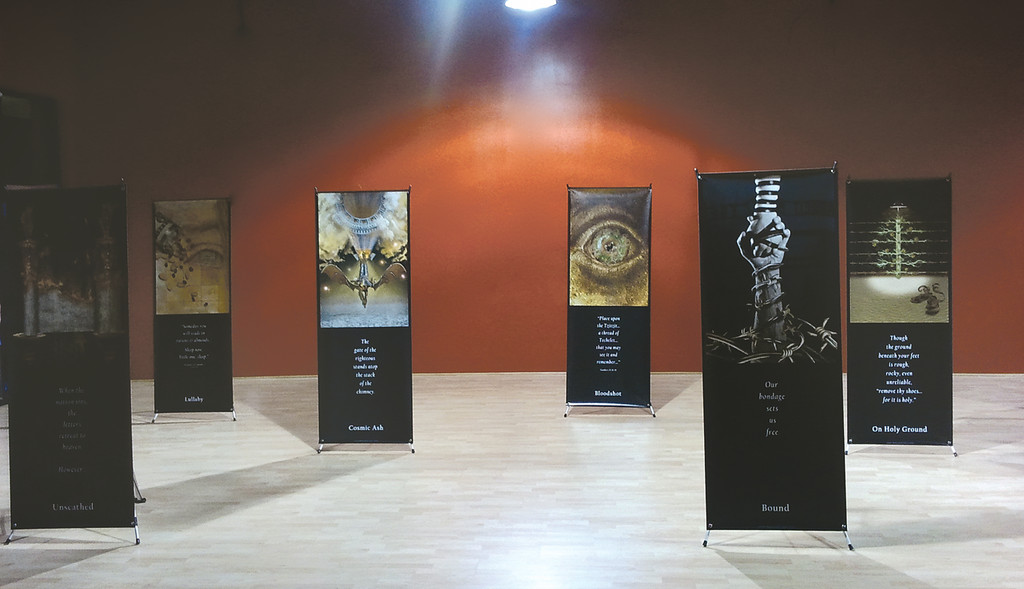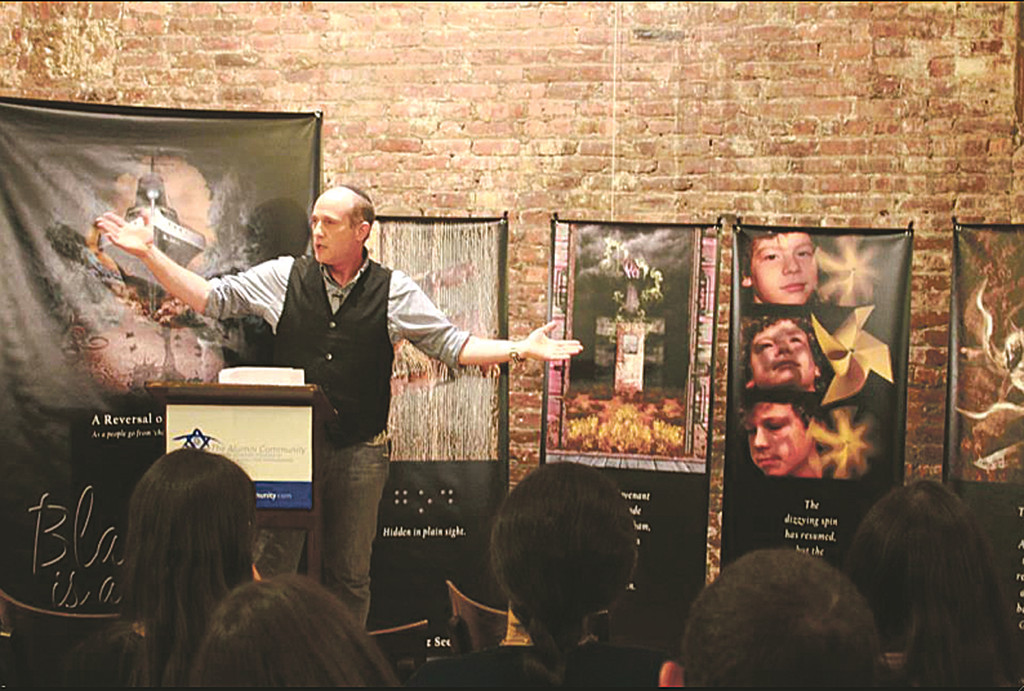YILC hosts Holocaust art exhibit “Black is a Color”
The images are vivid, wrenching, visceral and simultaneously reaching, grasping and reassuring, thought provoking, connecting. The Young Israel of Lawrence Cedarhurst is hosting an exhibit of 22 of Stan (Shlomo) Lebovic’s art works, “Black is a Color,” this Motzai Shabbat (Saturday evening), January 12, at 8:00 pm.
Lebovic’s work is a blending of Holocaust images and Jewish concepts. It is a synthesis of deep analytical philosophic Torah and Jewish historic insights, connecting ties to G-d, and Holocaust references.
Lebovic has toured the U.S., presenting his art and explanations to synagogues, schools, and Holocaust museums with requests to go beyond an hour’s discussion to feature lecture series, and Shabbatons. The current exhibit consists of 22 two-foot by six-foot freestanding banners. Lebovic presents his art and explains his ideas, philosophy and creative process about six of the works. His work is also available in book form, with each image printed along with one of his essays related to the art. He is also in the process of completing work on a Haggadah.
Lebovic was born in Los Angeles, California in 1963, the son of a Holocaust survivor, raised and comforted by the embrace of his father’s tattooed arm. “I remember him talking about his past from the earliest age,” recalls Lebovic. “His manner of discussion provided a relatively safe environment for him to discuss what had happened to him. He really left his emotions in the camps, and spoke of his ordeal in a very non-emotional, almost matter of fact manner. I never got the sense that he was bitter or sad. No tears, no anger. I was very interested in what he went through. I think the fact that my mother had not gone through the war--she grew up in Bogota, Columbia--and she was genuinely interested in hearing his story along with us, gave me and my brother the security we needed to endure and the comfort we needed to press on with questions. The stories left me with a profound sense of purpose. When someone’s father says he truly believes that he was saved by the hand of G-d, it begs the question, ‘Why would G-d go out of His way to save my father? Could I afford to turn my back on such a legacy or is it incumbent upon me to make G-d’s efforts worthwhile?’
“Having been told by my father that he continued to believe in G-d, I quickly developed a relationship with G-d. I was not raised religious, but I was raised to be faithful. As I grew, my connection to G-d continued to expand and take on more and more of the religion. By the time I was in my upper teens I began keeping Shabbos and, after high school, I went to Israel and attended yeshiva. The Holocaust began as a great motivator, but as I grew and became religious, I encountered more and more internal turmoil over the existence of so much evil in a world that I believed was guided by a good G-d. When I could no longer quiet the demons, I wanted to use my creative abilities to portray my struggle.”
He studied at the Corcoran School of Art in Washington, D.C., owned several illustrative service companies, and published a children’s book. He gave his business to an employee in 2007 for a percentage of future revenue. “I simply could not focus on the art and the business so I had to make a choice,” Lebovic explained. He terms his work a “personal quest” not knowing how far this would take him in delving into his issues or how much he would produce. He focused on what was “most disturbing at the moment” characterizing this as a “very emotionally charged period of time.” He produced each work with long essays and began to display his work in response to others’ requests to see it. He explains his creative and analytical process, providing him with “the opportunity to continue my exploration along with others and, together, grapple with the really big issues.”
As for his studies of the Haggadah, he terms it, “the single document which Judaism chooses to use as the vehicle for transmitting faith from one generation to the next.” Rather than analyzing it at the Seder night, he “decided to hold up each section to the light and see if I couldn’t find monumental expressions of faith in every word.”
Rabbi David Fohrman, Resident Scholar, Young Israel of Woodmere and Lead Educator, Aleph Beta, is familiar with Lebovic’s work. “What is particularly remarkable about the personal viewpoint he constructs, is its fusion of dark experience with the light and illumination that comes from a profound meditation on Jewish sacred texts,” Fohrman pointed out. “Stan takes pieces of text that are very familiar to many of us, and makes them unfamiliar, strange, and glorious in his new retelling of them. He searches out the ambiguities in these texts, the irony latent in them – and then lays them before our eyes, in newly unfamiliar form, along with images to match. The combined effect can shake the reader loose of his preconceived notions, comfortable and banal assumptions, like very little else can. In the end, the viewer who experiences Stan’s work may be disconcerted by it, but, if he truly opens himself or herself to it, he may well find himself spiritually refreshed and invigorated as well.”
Lebovic is Orthodox and currently lives with his wife and children in Baltimore, Maryland. To create his work, he pointed out that he uses a digitized tablet to draw images in computer illustration programs and combines photographs with his art, three dimensional renderings, textures and scans, and blends them “into the image I am looking to achieve.”
He said that he is anticipating introducing and discussing his work at YILC, noting that each exhibit is unique. “I would like viewers to form their own impressions of the work before diving into my intended message. Many pieces are intentionally left in a state of flux. They can be interpreted in almost opposite directions. After all, that is what life offers us. Events that can be interpreted one way or another. The choice is ours and I believe that variety is a valuable contribution to any important issue. I enjoy hearing interpretations of my work which I did not intend to present. Such revelations only serve to expand the discussion and include valuable insights. I hope to learn a lot and continue this journey with those in attendance.”
The Young Israel of Lawrence-Cedarhurst is located at 8 Spruce Street, Cedarhurst, New York, 11516.

 50.0°,
Overcast
50.0°,
Overcast 









